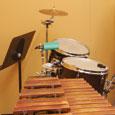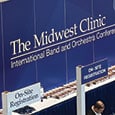.jpg) Music educators at all levels often struggle with the diverse knowledge and techniques necessary to teach percussion. The problem begins at the college level with percussion methods courses that offer only a smattering of training and pedagogy. If students seek the help of percussionists who teach, these professionals usually even find it difficult to provide high-quality instruction and still perform in large ensembles. After graduation, percussion performance majors may discover a gap between their specialized studio training and the practical use of their skills in different musical venues.
Music educators at all levels often struggle with the diverse knowledge and techniques necessary to teach percussion. The problem begins at the college level with percussion methods courses that offer only a smattering of training and pedagogy. If students seek the help of percussionists who teach, these professionals usually even find it difficult to provide high-quality instruction and still perform in large ensembles. After graduation, percussion performance majors may discover a gap between their specialized studio training and the practical use of their skills in different musical venues.
No one is at fault. There is simply too much to teach and learn. From my career as a professional percussionist and educator, I have culled ten tips that supplement basic instruction at all levels; they should help everyone – students and teachers – who want to polish their percussion skills.
Prepare for entrances with sticks or mallets touching the surface to be played. The starting position helps players produce the correct timbre, dynamic, and attack, particularly in delicate entrances. This approach lets players feel the point of contact, begin the passage more confidently, and relieve any nervous shaking. Students on drumset and multiple percussion can also use this tip for the feet and pedals. One exception is when a drum line starts in various positions for visual effect.
Carefully prepare for instrument switches. Many percussion parts are scored for multiple instruments in a short stretch of music that require stick changes, alternating between notated parts, and even moving to an entirely new station of instruments. Reducing wasted effort is the key to making smooth switches.
Use multi-purpose mallets creatively. Snare sticks can be fitted with timpani felt at one end and a round of metal on the shank to produce good sounds on the drum, timpani, and triangle. Some combination mallets can be purchased while others can be developed with ingenuity. Set up multiple stick trays to avoid carrying sticks back and forth. By eliminating these distractions, the music takes priority over logistics.
Master the less common instruments. I remember playing one orchestral work with an extremely difficult 12-tone melody on chimes. This part called on all of my practice work on chimes, including playing popular melodies, sightreading xylophone etudes, and improvising on the instrument. I recommend this thorough approach to the less-common instruments. Other oddities I have encountered were strong grooves with a shaker in each hand and dynamically and rhythmically intricate slapstick parts. Even though these situations are uncommon, they should not sound that way.
Listen to the instruments out in the audience. Timpani can frequently sound precise up close but muddled out in the audience. Likewise, a snare drum may sound buzzy up close but different in the hall. Various marimba parts may require drastically different mallets to project the intended sound to the seats. Find someone to alternate playing and listening in various locations in the hall.
Check all instruments carefully before playing. Opera and musical theater often require two performances of the same show in one day. In these instances, I always test every part of every instrument before the second performance. This includes playing straight up the white keys and down the black keys of the keyboard instruments as well as tapping the snare drum with the snares off and on to check response. I also assess timpani tuning to see if the temperature and humidity have produced changes. These checks take just a minute but are well worth the trouble.
Focus on sound. Although many percussion parts are sparse, it is important to make every note sound just right. Slight adjustments in instrument choices, instrument height, mallet selection, and head tension can make a big difference. When selecting a pair of crash cymbals, play close attention to the other instrumentation, the mood of the music, and the tempo to choose just the right sound. A good cymbal player may use two or three pairs in rotation during a relatively short piece, to match the best sound to each musical moment.
Make wise choices when mapping cues. Percussion entrances can be quite difficult, often coming during transitions in tempo and dynamics. If the ensemble is not playing together well, follow the largest group. In an orchestra a percussionist would follow the tempo of the strings rather than one player in the trombone section. However, if everyone is playing together well, go with the fastest-moving subdivision to calculate the entrance. If the strings are playing half notes and the trombones have 16ths, use the trombones to pinpoint the entrance.
Write all over the music. Many studio teachers tell students not to mark parts, but professional players write all over their music. Whether playing a classical work or drumset charts, the professionals use symbols, color coding, and written instructions whenever necessary. The goal should be to play the music to its fullest potential, not to turn in spotless music.
Breathe. Thoughtful breathing helps percussionists line up with other instruments at entrances. Percussionists do not have the luxury of easing into an attack. All wind players and many string players breath before entrances, and such deliberate breathing can help percussionists unite with the rest of the group. Full, regular breathing can also relax the body and focus the mind during performances.
Work more frequently with the weak hand. Of all the advice I have given to students over the years, this is perhaps the easiest and most transformative. For most people there is a gap in the skills of the two hands. Numerous daily tasks are handled by the strong hand, while the other sits idle.
Some years ago I began brushing my teeth with the weak hand and found it nearly impossible; now it feels strange to brush with my strong hand. Such tasks as unlocking doors, eating with a fork, and clicking the remote can improve weak-hand dexterity tremendously over time. The key is to be committed to practicing these tasks. I have adult students who have switched the mouse to the other side of the computer at work. Balanced skill with both hands will yield greater consistency and confidence in practice and performance.
These bits of advice should be helpful to music teachers and students, college percussion instructors and majors, music education professors and conductors, as well as aspiring professional players of any age. They are based on practical experience – on-the-job training – not to be found in method books or brought up in college percussion classes.






